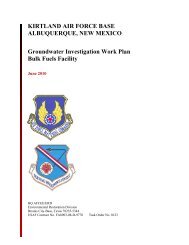Final FONSI and EA for hot cargo pad on Kirtland AFB - Kirtland Air ...
Final FONSI and EA for hot cargo pad on Kirtland AFB - Kirtland Air ...
Final FONSI and EA for hot cargo pad on Kirtland AFB - Kirtland Air ...
Create successful ePaper yourself
Turn your PDF publications into a flip-book with our unique Google optimized e-Paper software.
<str<strong>on</strong>g>Final</str<strong>on</strong>g> <str<strong>on</strong>g>EA</str<strong>on</strong>g> Addressing C<strong>on</strong>structi<strong>on</strong>, Operati<strong>on</strong>, <str<strong>on</strong>g>and</str<strong>on</strong>g> Maintenance of a Hot Cargo Pad<br />
building shall file an asbestos notificati<strong>on</strong> with the department no fewer than 10 calendar days be<str<strong>on</strong>g>for</str<strong>on</strong>g>e the<br />
start of such activity. Written asbestos notificati<strong>on</strong> certifying to the presence of ACM is required even if<br />
regulated ACM is not or may not be present in such buildings or structures.”<br />
3.5 Geology <str<strong>on</strong>g>and</str<strong>on</strong>g> Soils<br />
3.5.1 Definiti<strong>on</strong> of the Resource<br />
Geological resources c<strong>on</strong>sist of the Earth’s surface <str<strong>on</strong>g>and</str<strong>on</strong>g> subsurface materials. Within a given<br />
physiographic province, these resources typically are described in terms of topography <str<strong>on</strong>g>and</str<strong>on</strong>g> physiography,<br />
geology, soils, <str<strong>on</strong>g>and</str<strong>on</strong>g>, where applicable, geologic hazards <str<strong>on</strong>g>and</str<strong>on</strong>g> pale<strong>on</strong>tology. Topography <str<strong>on</strong>g>and</str<strong>on</strong>g> physiography<br />
pertain to the general shape <str<strong>on</strong>g>and</str<strong>on</strong>g> arrangement of a l<str<strong>on</strong>g>and</str<strong>on</strong>g> surface, including its height <str<strong>on</strong>g>and</str<strong>on</strong>g> the positi<strong>on</strong> of its<br />
natural <str<strong>on</strong>g>and</str<strong>on</strong>g> human-made features. Geology is the study of the Earth’s compositi<strong>on</strong> <str<strong>on</strong>g>and</str<strong>on</strong>g> provides<br />
in<str<strong>on</strong>g>for</str<strong>on</strong>g>mati<strong>on</strong> <strong>on</strong> the structure <str<strong>on</strong>g>and</str<strong>on</strong>g> c<strong>on</strong>figurati<strong>on</strong> of surface <str<strong>on</strong>g>and</str<strong>on</strong>g> subsurface features. Such in<str<strong>on</strong>g>for</str<strong>on</strong>g>mati<strong>on</strong><br />
derives from field analysis based <strong>on</strong> observati<strong>on</strong>s of the surface <str<strong>on</strong>g>and</str<strong>on</strong>g> borings to identify subsurface<br />
compositi<strong>on</strong>.<br />
Soils are the unc<strong>on</strong>solidated materials overlying bedrock or other parent material. Soils typically are<br />
described in terms of their complex type, slope, <str<strong>on</strong>g>and</str<strong>on</strong>g> physical characteristics. Differences am<strong>on</strong>g soil<br />
types in terms of their structure, elasticity, strength, shrink-swell potential, <str<strong>on</strong>g>and</str<strong>on</strong>g> erosi<strong>on</strong> potential affect<br />
their abilities to support certain applicati<strong>on</strong>s or uses. In appropriate cases, soil properties must be<br />
examined <str<strong>on</strong>g>for</str<strong>on</strong>g> their compatibility with particular c<strong>on</strong>structi<strong>on</strong> activities or types of l<str<strong>on</strong>g>and</str<strong>on</strong>g> use.<br />
Prime farml<str<strong>on</strong>g>and</str<strong>on</strong>g> is protected under the Farml<str<strong>on</strong>g>and</str<strong>on</strong>g> Protecti<strong>on</strong> Policy Act (FPPA) of 1981. Prime farml<str<strong>on</strong>g>and</str<strong>on</strong>g><br />
is defined as l<str<strong>on</strong>g>and</str<strong>on</strong>g> that has the best combinati<strong>on</strong> of physical <str<strong>on</strong>g>and</str<strong>on</strong>g> chemical characteristics <str<strong>on</strong>g>for</str<strong>on</strong>g> producing<br />
food, feed, <str<strong>on</strong>g>for</str<strong>on</strong>g>age, fiber, <str<strong>on</strong>g>and</str<strong>on</strong>g> oilseed crops, <str<strong>on</strong>g>and</str<strong>on</strong>g> is also available <str<strong>on</strong>g>for</str<strong>on</strong>g> these uses. The soil qualities,<br />
growing seas<strong>on</strong>, <str<strong>on</strong>g>and</str<strong>on</strong>g> moisture supply are needed <str<strong>on</strong>g>for</str<strong>on</strong>g> a well-managed soil to produce a sustained high<br />
yield of crops in an ec<strong>on</strong>omic manner. The l<str<strong>on</strong>g>and</str<strong>on</strong>g> could be cropl<str<strong>on</strong>g>and</str<strong>on</strong>g>, pasture, rangel<str<strong>on</strong>g>and</str<strong>on</strong>g>, or other l<str<strong>on</strong>g>and</str<strong>on</strong>g>, but<br />
not urban developed l<str<strong>on</strong>g>and</str<strong>on</strong>g> or water. The intent of the FPPA is to minimize the extent that Federal<br />
programs c<strong>on</strong>tribute to the unnecessary c<strong>on</strong>versi<strong>on</strong> of farml<str<strong>on</strong>g>and</str<strong>on</strong>g> to n<strong>on</strong>agricultural uses. The Act also<br />
ensures that Federal programs are administered in a manner that, to the extent practicable, will be<br />
compatible with private, state, <str<strong>on</strong>g>and</str<strong>on</strong>g> local government programs <str<strong>on</strong>g>and</str<strong>on</strong>g> policies to protect farml<str<strong>on</strong>g>and</str<strong>on</strong>g>.<br />
The implementing procedures of the FPPA <str<strong>on</strong>g>and</str<strong>on</strong>g> Natural Resources C<strong>on</strong>servati<strong>on</strong> Service (NRCS) require<br />
Federal agencies to evaluate the adverse effects (direct <str<strong>on</strong>g>and</str<strong>on</strong>g> indirect) of their activities <strong>on</strong> prime <str<strong>on</strong>g>and</str<strong>on</strong>g><br />
unique farml<str<strong>on</strong>g>and</str<strong>on</strong>g>, <str<strong>on</strong>g>and</str<strong>on</strong>g> farml<str<strong>on</strong>g>and</str<strong>on</strong>g> of statewide <str<strong>on</strong>g>and</str<strong>on</strong>g> local importance, <str<strong>on</strong>g>and</str<strong>on</strong>g> to c<strong>on</strong>sider alternative acti<strong>on</strong>s that<br />
could avoid adverse effects. Determinati<strong>on</strong> of whether an area is c<strong>on</strong>sidered prime or unique farml<str<strong>on</strong>g>and</str<strong>on</strong>g><br />
<str<strong>on</strong>g>and</str<strong>on</strong>g> potential impacts associated with a proposed acti<strong>on</strong> is based <strong>on</strong> preparati<strong>on</strong> of the farml<str<strong>on</strong>g>and</str<strong>on</strong>g><br />
c<strong>on</strong>versi<strong>on</strong> impact rating <str<strong>on</strong>g>for</str<strong>on</strong>g>m AD-1006 <str<strong>on</strong>g>for</str<strong>on</strong>g> areas where prime farml<str<strong>on</strong>g>and</str<strong>on</strong>g> soils occur <str<strong>on</strong>g>and</str<strong>on</strong>g> by applying<br />
criteria established at Secti<strong>on</strong> 658.5 of the FPPA (7 CFR 658). The NRCS is resp<strong>on</strong>sible <str<strong>on</strong>g>for</str<strong>on</strong>g> overseeing<br />
compliance with the FPPA <str<strong>on</strong>g>and</str<strong>on</strong>g> has developed the rules <str<strong>on</strong>g>and</str<strong>on</strong>g> regulati<strong>on</strong>s <str<strong>on</strong>g>for</str<strong>on</strong>g> implementati<strong>on</strong> of the Act<br />
(see 7 CFR Part 658, 5 July 1984).<br />
3.5.2 Existing C<strong>on</strong>diti<strong>on</strong>s<br />
Regi<strong>on</strong>al Geology. The City of Albuquerque <str<strong>on</strong>g>and</str<strong>on</strong>g> Kirtl<str<strong>on</strong>g>and</str<strong>on</strong>g> <strong>AFB</strong> are near the juncti<strong>on</strong> of five<br />
physiographic provinces: the Colorado Plateau, the Basin <str<strong>on</strong>g>and</str<strong>on</strong>g> Range, the Southern Rocky Mountains, the<br />
Rio Gr<str<strong>on</strong>g>and</str<strong>on</strong>g>e rift, <str<strong>on</strong>g>and</str<strong>on</strong>g> the Great Plains (Grant 1981). Kirtl<str<strong>on</strong>g>and</str<strong>on</strong>g> <strong>AFB</strong> is in the eastern margin of the<br />
Albuquerque Basin, a major feature of the Rio Gr<str<strong>on</strong>g>and</str<strong>on</strong>g>e rift. The Rio Gr<str<strong>on</strong>g>and</str<strong>on</strong>g>e rift is approximately<br />
620 miles l<strong>on</strong>g <str<strong>on</strong>g>and</str<strong>on</strong>g> is bordered <strong>on</strong> the west by the Colorado Plateau <str<strong>on</strong>g>and</str<strong>on</strong>g> <strong>on</strong> the east by the Great Plains.<br />
The Albuquerque Basin is north-trending <str<strong>on</strong>g>and</str<strong>on</strong>g> is approximately 90 miles l<strong>on</strong>g <str<strong>on</strong>g>and</str<strong>on</strong>g> 31 miles wide. It<br />
Kirtl<str<strong>on</strong>g>and</str<strong>on</strong>g> <strong>AFB</strong>, NM January 2011<br />
3-14
















